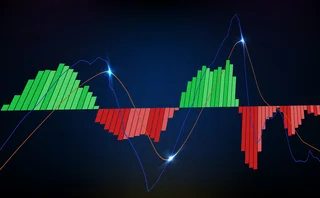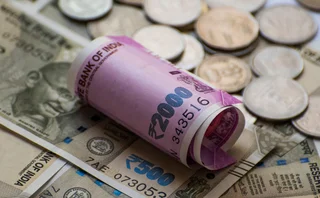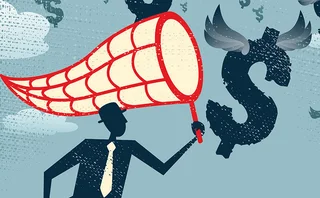
Investors look to profit from record low equity volatility
Volatility is trading at record lows globally and especially in Asia. Why is it so low and does it represent an opportunity for volatility funds to buy at discounted levels or is something more sinister at play?

A hedge fund volatility trader compares the current state of the volatility markets to a "reduced to clear" sign at a supermarket: at first glance it appears heavily discounted but on further inspection it's not necessarily good value.
Globally, volatility is at multi-year lows across equity indexes, which could be interpreted in a positive light that six years on since the financial crisis the economic recovery has taken hold, the eurozone poses a reduced risk, bank balance sheets are in better shape and imminent and impending risk of a large tail event is not realistically in view.
Furthermore, despite the headlines over a potential China slowdown and related credit issues, volatility markets are still pricing China risk at all-time lows. The story is further complicated in Asia, however, as structured products issuance heavily influences the price of volatility. Retail investors in Japan and Korea have historically sold puts embedded within equity-linked autocallable structures to dealers to collect extra premium and juice up returns, which has a knock-on effect of pushing down volatility.
"In the US, in contrast, insurers are buying long-dated puts on the S&P index and the variable annuities business is pushing volatility higher than it should be," says Guillaume Derville, head of equity derivatives strategy at BNP Paribas in Hong Kong.
An increase in Korean investors selling puts on the HSCEI – the index that tracks the performance of China enterprises listed in Hong Kong in the form of H-shares – and the Kospi 200 has pushed volatility sharply downward. On May 16, three-month implied volatility on the HSCEI hit a new low of 17.9%, which compares with levels of 21% a year ago and a high of 99% in the midst of the financial crisis in October 2008. In Korea too, volatility is heavily discounted, trading at 10% compared with 15% a year ago while in the US S&P volatility is at 12% compared with 60% during the crisis.
For the year until May 22, total issuance of public and private equity-linked securities in Korea had already reached 21.8 trillion won ($21.3 billion) compared with total issuance last year of 45.4 trillion won.
Worst-of structures have been popular with Korean retail investors, as this feature allows an increase in the coupon with the payout based on the worst performing index. Worst-of structures were introduced because Kospi 200 volatility was becoming too low and investors wanted higher coupons: initially Kospi 200/SPX was most popular but now traders report volumes have concentrated on Kospi 200/HSCEI as volatility on the latter is significantly higher.
"With a worst-of structure the vega concentrates on the worst performer, and for the past six months it has been HSCEI where volatility is being pushed further and further down. We estimate that new issuance amounts to €10 million of vega per month on Kospi 200 and HSCEI combined or five million on each but it doesn't reflect the outstanding vega on the Street as it's not static," says Ann Tranqui, head of flow derivatives sales at Societe Generale in Hong Kong.
Vega measures the sensitivity to an underlying's volatility so when spot goes down dealers' vega inventory inflates, while it disappears when volatility and spot rise. "Recent spot action has inflated the overall vega position, making it very heavy in the books," says Tranqui.
Dealers will also hedge their book by selling puts when first issuing autocallable products. "If the market then moves lower during the life of the trade the dealing desk will tend to get longer volatility on that underlying, especially if the decline happens on a continuing, grinding basis," says Pete Clarke, global head of equity derivatives strategy at UBS in London.
According to Clarke the maturity of this vega position shifts further out along the curve as spot levels decline to match the now longer expected maturity of the product, narrowing the spread between implied and realised volatility, even if the market is selling off based on fundamentals.
Indeed, implied volatilities on the Kospi 200 and HSCEI have been trading below realised volatility reflecting the benign sentiment across markets. This contrasts strikingly with the period during and shortly after the financial crisis which was characterised by high realised and even higher implied volatility as investors were concerned about risk in the market. "As usual we then saw a gradual compression in volatility as the memory of the crisis faded, investors became more complacent, and the natural supply of volatility came back into the market," says Clarke.
Dealers agree that the current situation in China and Korea is reminiscent of Japan before the catalyst of Abenomics provided a huge upswing in spot and volatility in the Japan market.
"Chinese and Korean equities are cheap; it is true from a valuation perspective but also on an excess profitability basis – return on equity minus cost of equity. The current situation is paradoxical as we witness a double dislocation, both in valuation and in volatility," says Derville.
Clarke at UBS believes the current market pattern presents a great opportunity to buy cheap call options and says that institutional investors have been using long-dated calls as a way to express a tentative bullish view with limited short-term downside risk.
"When equity markets have been depressed for a long time, it's arguably ever more likely that some form of stimulus will emerge from policy makers. At the same time, when long-dated volatility and forward levels are so depressed, the premium required to get long via a call option is relatively low. The absolute cost of, say, a five year at-the-money call on HSCEI isn't that much more than what you'd have to allocate to initial margin on a futures position, and it arguably presents a much better risk/reward than an outright long equity position," he says. "These calls have a very low theta bill for the first years of the trade, good participation into any rise in spot or rates, a capped maximum downside, and the potential for volatility tailwinds on any large moves."
Tobias Hekster, a senior strategist at Hong Kong-based True Partner Fund, agrees that there is an opportunity out there. "From the perspective of realised volatility, these HSCEI options are an interesting proposition. In Asia you get the phenomenon of ‘spot up volatility up' so if equities rise volatility could be like a coil jumping up. And if the Chinese government steps in and reinforces the market you could get a 5% move up, which will also result in volatility rising."
Hekster isn't the only one to see opportunities in China, despite the record low levels of volatility. Bing Zhang, portfolio manager at hedge fund Trinitus Asset Management in Hong Kong, says he has profited from volatility coming down by being a "net seller" of equity volatility since the talk of the US tapering its quantitative easing (QE) programme last year caused a spike in volatility across Asia.
Zhang's rationale is simple: since 2008 implied volatility in general, and in HSCEI in particular, has been elevated and when you factor in the ongoing QE programmes from both the European Central Bank and Bank of Japan there is a net liquidity injection and as a consequence realised volatility will be contained.
"It has worked out well for us – I'm expecting a profit of four to five volatility points," says Zhang. "Fundamentally I'm bearish on China but the risk parameters in pricing tail events are expensive. HSCEI volatility is still not a buy as downside risk and tail risk have been overpriced. Even if spot decreases further volatility won't blow up."
According to Zhang, a lack of understanding of the Chinese system means global investors, who are still the main buyers of Asian volatility, are overestimating the potential downside risk posed by China's credit problems.
"Each time we meet someone from Texas, New York and London they say China will blow up but they are losing the sense of locality. The defaults earlier this year were used by the government and central bank as a way to penalise certain risk takers but in a controlled way," he says.
Having correctly chosen to be short volatility Zhang believes current levels are attractive to look opportunistically to load up long but he says timing is the big challenge as volatility traders burn theta – the time decay on the value of an option as it moves closer to maturity, or its depreciation – every day when realised volatility is low.
"To minimise the negative carry we buy long-dated Nikkei volatility as it has a nice term structure – the first six months is upward sloping but thereafter it comes off in 2018–2020. An even smarter way is to use a forward starting volatility structure because the longer end is downward sloping so it's cheaper to buy than outright. For example, 2018 is trading at 17 volatility points so buying a 2014 straddle you would pay 17 volatility but using a 2015 start into 2018 cheapens the trade to 16 volatility points or lower," says Zhang.
The downside to using the forward starting option is if volatility spikes significantly before 2015 and as a result Zhang has started to load up on volatility.
"Whatever the Bank of Japan does will be a game changer – whether it acts or doesn't will move the market but elsewhere compared to realised volatility it is expensive. You need to buy volatility just before an event and nobody has that predictive power," he says.
Derville from BNP Paribas says that to mitigate the painful carry of holding a long volatility position when volatility keeps moving lower, his clients are using relative value strategies to go long Asian volatility versus short S&P or the Australian AS51, the benchmark Australian index. "Entry points are attractive when using vanilla options and the carry is positive; investors are also using these strategies to hedge against tail risk events, knowing that in such scenarios, Asian volatility should spike higher than S&P volatility," he says.
Clearly the respective entry levels are a crucial factor in the ultimate profitability of the trade but not everyone agrees that Asian volatility is a buy, even on a hedged basis.
"There is an opportunity but if the market tanks due to a tail/geopolitical event the S&P will be more reactive than we saw in 2008. In the first 10%–20% move down, S&P volatility will move higher than in Asia but with the HSCEI below 7,000 and Nikkei 225 below 11,000 Asian volatility will explode. In the first leg down, however, you have mark-to-market losses on your relative value volatility position," says Benjamin Clerget, partner and head of equity derivatives trading at BTG Pactual in London.
Clerget says the structure of autocallables means that if spot goes down the Street is longer vega, depressing volatility down; but this is reversed when products knock out, driving a huge volatility spike.
"In Asia we are monitoring the situation but haven't yet found good long volatility entry levels. On the Nikkei within this range, two-year volatility can go two points lower quickly and then it will be a big opportunity. HSCEI is a value trap right now – volatility is low but it's low in every market. We want to be long naked volatility to get crash protection rather than doing relative value trades that don't perform because if the market crashes at the beginning, the relative value risk/reward isn't good enough," he says.
Indeed investors that entered into long volatility positions earlier this year may have found their positions underwater but picking the bottom is difficult. "The issue is whether we have seen the lows. Investors that bought volatility on Hong Kong indexes earlier in the year will be hurting now. If implied volatility declines further it hurts on a mark-to-market basis just as an investor that bought Asian volatility last year before June would have benefited from the volatility caused by the talk of tapering," says Hekster at True Partner.
According to Clerget, equity volatility should be evaluated in relation to volatility in other asset classes and he says that Asian volatility is low compared with the S&P, but it can still fall further relative to currency and rates. For example, the euro is trading at seven volatility points compared with nine a year ago and yen is now eight compared with 12 a year ago, or 30% lower.
As Zhang points out, there is still potential to profit even in low volatility markets and with volatility distorted by the Asian structured products flow, further opportunities abound.
Tranqui at SG says: "Investors looking for protection in China have been able to buy cheap HSCEI puts. Given the outlook and growth concerns in China, HSCEI should reflect high volatility but it's the opposite effect as the structured product flow is predominant."
Clerget agrees that while China is traversing a more difficult period, volatility should be higher but he says the tone is being reflected instead in the lack of interest and volumes. "This market is now a slow death: people are no longer investing so it is grinding lower and that's not good for volatility as you need an unexpected event for a spike in volatility and in China so far everything is priced in. The dividend yield on HSCEI is the highest of any developed markets at above 4% so either spot is too low or dividends are too high."
In other words, the market could be past its sell-by date.
Only users who have a paid subscription or are part of a corporate subscription are able to print or copy content.
To access these options, along with all other subscription benefits, please contact info@risk.net or view our subscription options here: http://subscriptions.risk.net/subscribe
You are currently unable to print this content. Please contact info@risk.net to find out more.
You are currently unable to copy this content. Please contact info@risk.net to find out more.
Copyright Infopro Digital Limited. All rights reserved.
You may share this content using our article tools. Printing this content is for the sole use of the Authorised User (named subscriber), as outlined in our terms and conditions - https://www.infopro-insight.com/terms-conditions/insight-subscriptions/
If you would like to purchase additional rights please email info@risk.net
Copyright Infopro Digital Limited. All rights reserved.
You may share this content using our article tools. Copying this content is for the sole use of the Authorised User (named subscriber), as outlined in our terms and conditions - https://www.infopro-insight.com/terms-conditions/insight-subscriptions/
If you would like to purchase additional rights please email info@risk.net
More on Equity markets
The future of equity derivatives: perspectives for UK equities and dividends
Managing equity and dividend risk today requires new trading strategies and products. In a webinar convened by Risk.net and hosted by Eurex, three experts discuss what’s next for the UK and European markets.
Follow the moneyness
Barclays quants extend Bergomi’s skew stickiness ratio to all strikes
What gold's rise means for rates, equities
It has been several years since we have seen volatility in gold. An increase in gold volatility can typically be associated with a change in sentiment and investor behavior. The precious metal has surged this year on increased demand for safe haven…
Breaking the collateral silos – Navigating regulation with a strategic alternative
Emmanuel Denis, head of tri‑party services at BNP Paribas Securities Services, discusses why financial institutions must rethink old practices of collateral management and instead adopt a tri-party approach, with which equities can be managed as…
BAML and Morgan Stanley shift Indian P-notes to Europe
Tax changes trigger move out of Mauritius and Singapore
Volatility traders wrestle with digital risk of Brexit
Skew on major indexes leaps after market wakes up to risks of UK's referendum
New US tax rules could hamper ETN market, dealers warn
IRS’s forthcoming Section 871(m) rules could inadvertently capture legacy ETNs
Dealers fear death of dividend risk premia strategy
Shrinking dividend futures premium hurting investors







